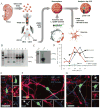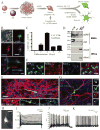L1 retrotransposition in human neural progenitor cells
- PMID: 19657334
- PMCID: PMC2909034
- DOI: 10.1038/nature08248
L1 retrotransposition in human neural progenitor cells
Abstract
Long interspersed element 1 (LINE-1 or L1) retrotransposons have markedly affected the human genome. L1s must retrotranspose in the germ line or during early development to ensure their evolutionary success, yet the extent to which this process affects somatic cells is poorly understood. We previously demonstrated that engineered human L1s can retrotranspose in adult rat hippocampus progenitor cells in vitro and in the mouse brain in vivo. Here we demonstrate that neural progenitor cells isolated from human fetal brain and derived from human embryonic stem cells support the retrotransposition of engineered human L1s in vitro. Furthermore, we developed a quantitative multiplex polymerase chain reaction that detected an increase in the copy number of endogenous L1s in the hippocampus, and in several regions of adult human brains, when compared to the copy number of endogenous L1s in heart or liver genomic DNAs from the same donor. These data suggest that de novo L1 retrotransposition events may occur in the human brain and, in principle, have the potential to contribute to individual somatic mosaicism.
Figures




Comment in
-
Developmental biology: Jumping-gene roulette.Nature. 2009 Aug 27;460(7259):1087-8. doi: 10.1038/4601087a. Nature. 2009. PMID: 19713921 No abstract available.
Similar articles
-
L1 retrotransposition in neurons is modulated by MeCP2.Nature. 2010 Nov 18;468(7322):443-6. doi: 10.1038/nature09544. Nature. 2010. PMID: 21085180 Free PMC article.
-
Ataxia telangiectasia mutated (ATM) modulates long interspersed element-1 (L1) retrotransposition in human neural stem cells.Proc Natl Acad Sci U S A. 2011 Dec 20;108(51):20382-7. doi: 10.1073/pnas.1100273108. Epub 2011 Dec 9. Proc Natl Acad Sci U S A. 2011. PMID: 22159035 Free PMC article.
-
Somatic mosaicism in neuronal precursor cells mediated by L1 retrotransposition.Nature. 2005 Jun 16;435(7044):903-10. doi: 10.1038/nature03663. Nature. 2005. PMID: 15959507
-
L1 Mosaicism in Mammals: Extent, Effects, and Evolution.Trends Genet. 2017 Nov;33(11):802-816. doi: 10.1016/j.tig.2017.07.004. Epub 2017 Aug 7. Trends Genet. 2017. PMID: 28797643 Review.
-
L1 retrotransposons and somatic mosaicism in the brain.Annu Rev Genet. 2014;48:1-27. doi: 10.1146/annurev-genet-120213-092412. Epub 2014 Jul 14. Annu Rev Genet. 2014. PMID: 25036377 Review.
Cited by
-
Transposable elements in TDP-43-mediated neurodegenerative disorders.PLoS One. 2012;7(9):e44099. doi: 10.1371/journal.pone.0044099. Epub 2012 Sep 5. PLoS One. 2012. PMID: 22957047 Free PMC article.
-
Evaluating risks of insertional mutagenesis by DNA transposons in gene therapy.Transl Res. 2013 Apr;161(4):265-83. doi: 10.1016/j.trsl.2012.12.005. Epub 2013 Jan 10. Transl Res. 2013. PMID: 23313630 Free PMC article. Review.
-
Roles for retrotransposon insertions in human disease.Mob DNA. 2016 May 6;7:9. doi: 10.1186/s13100-016-0065-9. eCollection 2016. Mob DNA. 2016. PMID: 27158268 Free PMC article. Review.
-
Increased neuronal death and disturbed axonal growth in the Polμ-deficient mouse embryonic retina.Sci Rep. 2016 May 13;6:25928. doi: 10.1038/srep25928. Sci Rep. 2016. PMID: 27172884 Free PMC article.
-
Genomes of replicatively senescent cells undergo global epigenetic changes leading to gene silencing and activation of transposable elements.Aging Cell. 2013 Apr;12(2):247-56. doi: 10.1111/acel.12047. Epub 2013 Jan 30. Aging Cell. 2013. PMID: 23360310 Free PMC article.
References
-
- Muotri AR, et al. Somatic mosaicism in neuronal precursor cells mediated by L1 retrotransposition. Nature. 2005;435(7044):903–910. - PubMed
-
- Tang Y, Nyengaard JR, De Groot DM, Gundersen HJ. Synapse. 3. Vol. 41. New York, N.Y: 2001. Total regional and global number of synapses in the human brain neocortex; pp. 258–273. - PubMed
-
- Moran JV, et al. High frequency retrotransposition in cultured mammalian cells. Cell. 1996;87(5):917–927. - PubMed
Publication types
MeSH terms
Substances
Grants and funding
LinkOut - more resources
Full Text Sources
Other Literature Sources

